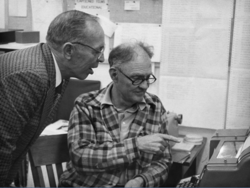Robert Weitbrecht
Robert Weitbrecht | |
|---|---|
 Dr. Weitbrecht shows off his TTY device. | |
| Born | April 11, 1920 |
| Died | May 19, 1983 (aged 63) |
| Nationality | American |
| Alma mater | University of California, Berkeley University of Chicago |
| Awards | 1971 Laurent Clerc Award |
| Scientific career | |
| Institutions | SRI International Weitbrecht Communications |
Robert Haig Weitbrecht (1920-1983) was an engineer at SRI International and later the spin-off company Weitbrecht Communications who invented a type of a modem (a form of acoustic coupler).
Early life and education
Weitbrecht was born in Orange, California in 1920.[1] He was born Deaf and his education was mainstream for the most part with the exception of acquiring some signing and lip-reading skills from a Deaf school early on. He went on to earn a B.S. in Astronomy from the University of California, Berkeley in 1942 and finished his formal education with a M.S. in Astronomy from the University of Chicago in 1957.
Career
Weitbrecht was initially a physicist at the Radiation Laboratory at the University of California (now Lawrence Livermore National Laboratory), then an electronics scientist at the U.S. Naval Air Missile Test Center.[2] For his efforts, he earned the United States Navy's Superior Accomplishment Award.[2][3]
Even in his high school days, Weitbrecht was interested in amateur radio and used radiotelegraph to communicate with fellow radio operators around the country.[4] In 1964, this love for communication came together with the need to interact with a colleague who could not operate an amateur radio. To solve this problem, Weitbrecht created a device that used the public telephone system to achieve communication: the teletypewriter (TTY).[1]
After being approached by James C. Marsters, Weitbrecht came up with a revised design for the acoustic coupler (a type of modem), which used echo suppression.[5][6] In 1964, Marsters and Weitbrecht adapted used teletypewriter equipment, and Weitbrecht made the first successful teletypewriter phone call from one deaf person to another. It took several tries, until Weitbrecht's words appeared clearly: "Are you printing now? Let's quit for now and gloat over the success."[7] Today, this type of device is known as a telecommunications device for the deaf.
Personal life
Weitbrecht earned a pilot's license in 1967.[8] Weitbrecht died after being involved in an automobile accident in 1983.[1]
References
- ^ a b c "About Us". Weitbrecht Communications. Archived from the original on 2006-12-30. Retrieved 2007-02-04.
- ^ a b "Robert H. Weitbrecht". Deaf Scientist Corner. Texas Women's University. Retrieved 2012-03-25.
- ^ "Robert Weitbrecht: Astronomer and Inventor". If My Hands Could Speak... 2009-07-27. Retrieved 2012-03-25.
- ^ Lang, Harry G. "Chapter One continued..." A Phone Of Our Own. Gallaudet University. Retrieved 2012-03-25.
- ^ Hevesi, Dennis (2009-08-22). "James Marsters, Deaf Inventor, Dies at 85". The New York Times. Retrieved 2012-03-25.
- ^ Stern, Virginia W.; Martha Ross Redden (December 1935). "Selected Telecommunications Devices for Hearing-Impaired Persons" (PDF). Office of Technology Assessment. Retrieved 2009-09-03.
- ^ Shapiro, T. Rees (2009-08-28). "James C. Marsters, 85: Phone System Increased Independence for Deaf". The Washington Post. Retrieved 2009-08-31.
- ^ Gannon, Jack (1981). Deaf Heritage–A Narrative History of Deaf America (PDF). Silver Spring, MD: National Association of the Deaf. pp. 198, 201.
